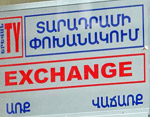There were no currency transactions in the NASDAQ OEMEX stock market on December 7. The reason is the rapid reduction of demand to US dollar.
The demand rate did not exceed 373.5 drams per dollar. In other words, banks did not pay more than 373.5 drams for one dollar. However, the supply rate did not change and the sellers did not agree to sell for less than 384.75 drams for one dollar. In a word, buyers and sellers of currency failed to come to an agreement on the price.
These process in the stock market influenced on the retail market as well, where the price of dollar was raised a little bit. According to the rate.am web site, yesterday trade banks paid 382.55 for one dollar (instead of 382.38 drams on December 6), and sold for 385.93 drams (382.88 drams on December 6).
The exchange rate of US dollar continues to grow despite predictions. The exchange rate used to go down till December one, but after that the price of US dollar started to grow again.
This tendency is against all forecasts and the experience of the past years. Usually the price of dollar goes down in December because workers come back from other countries and bring money with them, people send money to their relatives in Armenia to celebrate the holidays, etc. The price of dollar does not go down and it is now difficult to forecast decline in the price of foreign currency. It is evident that the people in charge of the economic policy want to follow the president’s commitment in the beginning of the year saying that the national currency would slowly devaluate. On the other hand, PM Tigran Sargsyan has taken the commitment not to let the level of inflation exceed the permitted level of 5.5% till the end of the year. If dollar’s price is increased, the price of imported products will increase too. In consideration of the fact that import has a large share in the domestic product, the increased prices of import will result in inflation.
By the way, according to the information of the national statistics service, the inflation level for 12 months is higher than the permitted level – 6.4%, and in case of consumer products it is even higher – 8.7%.
Even though the weak national currency supports export, it will not support the export during these several weeks only. On the other hand, a part of the society is interested in it too because they live on the account of foreign transfers from other countries. This is the needy part of the society and they are about 25-30% of the society.
According to the information of the Central Bank, during ten months of this year the capacity of money transfers for non-commercial purposes from abroad to Armenia was 1.24 billion dollars. In October months only 145 million dollars was transferred to Armenia. Even if the exchange rate is changed with one or two drams, for the big picture it cuts the incomes of this group of the society much. It is worth mentioning that the largest ‘donor’ continues to be Russia with more than one billion dollars transfer capacity to Armenia. This year it will be impossible to blame the authorities for wasting the money of pensioners by playing with the exchange rate.
Even though there have been many changes of the exchange rate, people still trust the foreign currency more than the national currency. Banks rust the foreign currency more too. According to the information of the CB, over 62% of credits issued by banks are in foreign currency, and even during this year there has been growth of dollarization. There are forecasts and opinions that the price of US dollar may reach 420 drams next year.

